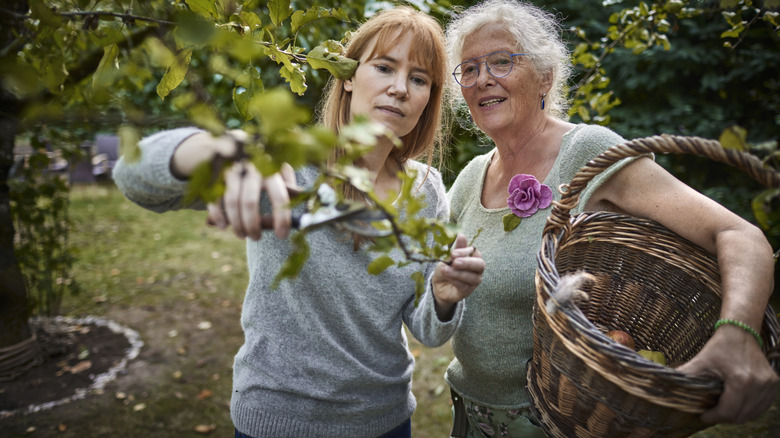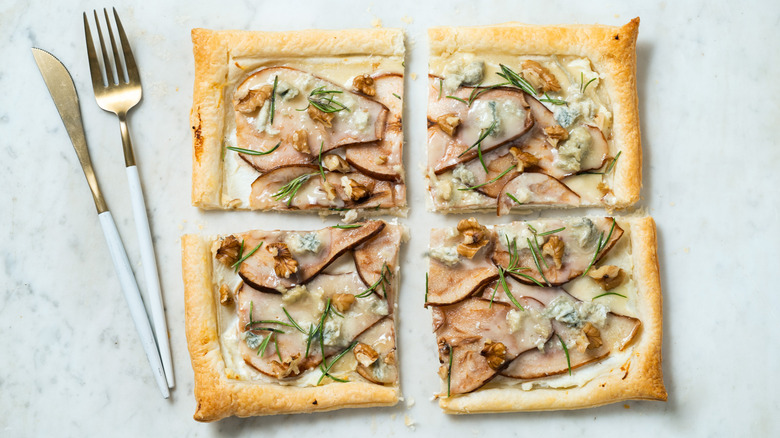This Fruit Tree Can Live Up To 400 Years In Your Garden
We may receive a commission on purchases made from links.
"Oh to be a pear tree — any tree in bloom! With kissing bees singing of the beginning of the world!" wrote Zora Neale Hurston in "Their Eyes Were Watching God." The subject? One of the oldest cultivated trees in North America — the pear tree. The European pear is a pretty flowering tree that can live and bear fruit for decades, and, at least in one famous case, hundreds of years in a garden. They usually live between 15 to 50 or so years, depending on climate and care.
The trees reach maturity in five to 10 years and bear fruit at around five years, which will be about 10 to 20 pounds annually, with that amount increasing as the tree ages. They thrive in USDA hardiness zones 5 through 8. This means pear trees can withstand zone 5's average lows of -20 to -15 degrees Fahrenheit all the way up to zone 8's lows of 15 to 20 degrees. Except for extremely hot and cold areas, pear trees can live in most of the continental United States. They prefer full sun, but can survive in partial shade, and they do best in moist soil with good drainage — though, they can thrive in sand or clay, too.
What's probably the most famous European pear tree is rooted in Danvers, Massachusetts, and is known as the Endicott pear tree. Planted in the 1630s, the Endicott pear is a testament to how sturdy and long-lasting European pear trees are. They're easy to cultivate, hardy, and bloom with bursts of dainty white or pink flowers in the spring. With well-known cultivars such as Bartlett, Bosc, and D'anjou, they're some of the world's most popular fruiting trees.
Creative ways to prepare pears
Once a tree bears fruit, the best way to store pears for lasting freshness is in a paper bag in the fridge. Just make sure you keep that bag in the crisper drawer.
If you're looking for unique ways to serve your homegrown pears, try poaching them to create a decadent treat. The best wines for poaching pears are pinot noir and sangiovese, mostly due to their high acidity. Once poached, the pears can be served in so many ways — warm with a dollop of ice cream, cold with some fresh whipped mascarpone, or baked into a pastry or pie.
Another way to serve pears is on a tempting cheese board. They tend to complement the taste of blue cheeses like Roquefort or Stilton, or aged ones like Gouda or Parmigiano. Pair your pears with a selection of chutneys or honey and mixed nuts for texture. Delish!
You could try some unconventional pear pairings, like roasted maple balsamic pears, or use them in a slaw with thinly sliced Brussels sprouts and beets with a dressing of oil, vinegar, Dijon mustard, and orange juice.
They're also great for baking. Replace apples with pears in a pie or in something like a simple fruit crumble with almonds; mix the chopped pears with a teaspoon of cinnamon and a tablespoon of flour, and a pinch of salt, then add a crumble topping including chopped almonds and bake at 350 degrees for up to an hour. Or use them in a savory recipe like a pizza or a puff pastry topped with sliced pears, the blue cheese of your choice, your favorite nut, and fresh herbs (rosemary or thyme work well here).


